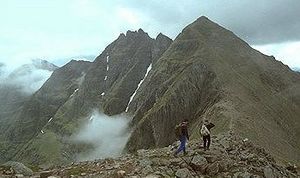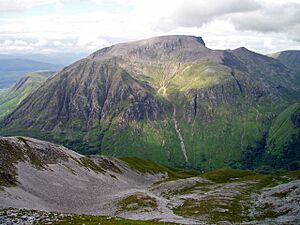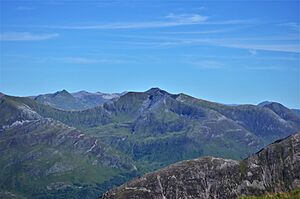Mountains and hills of Scotland facts for kids
Scotland is a country in the United Kingdom that's famous for its amazing mountains! These mountains are usually split into three main areas: the Scottish Highlands, the Central Belt, and the Southern Uplands. The Highlands are where you'll find the biggest and most famous mountains, but there are also many hills and mountains further south. This article will tell you all about them!
Ben Nevis is the tallest mountain in all of Scotland and the entire United Kingdom. It stands at about 4,413 feet (1,345 m) high! You'll find it in the Highland region, at the western end of the Grampian Mountains. In Scotland, a mountain that's over 3,000 feet (910 m) is called a Munro. There are 282 Munros in total!
Every year, hundreds of thousands of people visit Scotland's mountains, especially in winter. About 130,000 people even climb to the top of Ben Nevis each year!




Contents
Exploring Scotland's Highland Mountains
Scotland's main mountain area, the Scottish Highlands, can be divided into three parts: the Northwest Highlands, the Grampian Mountains, and the islands off the west coast.
Northwest Highlands: Wild and Rugged Peaks
The Northwest Highlands start north and west of the Great Glen. This area is home to 100 of Scotland's 282 Munros. The mountains here are often very rough and steep. However, some parts offer nice walks on grassy slopes. You'll find long ridges, especially around Glen Shiel in Kintail. Further north, you'll see more mountain ranges like the Fannichs.
The Torridon Hills are very popular for hillwalking, scrambling, and climbing. Some of these hills, like Beinn Eighe, have white quartzite caps, which make them look very unique. This white rock also appears on mountains like Foinaven and Arkle further north. Some hills here are made of Lewisian Gneiss, which is one of the oldest rocks on Earth! Many peaks in this region, especially in Assynt and Sutherland, stand alone. Even if they are smaller, they look very grand. Famous examples include Stac Pollaidh, Suilven, An Teallach, and Maiden Pap. The southern part of this area, south of Glenfinnan, has lower mountains called Corbetts and Grahams. They still have the rugged feel of the northern peaks. The tallest mountain in this area is Càrn Eige.
Popular Northwest Highland Areas
- Torridon, located west and southwest of Kinlochewe
- The Fannichs, found north-east of Kinlochewe
- Dundonnel and Fisherfield Forest, north of Kinlochewe
- Knoydart, situated north-east of Mallaig
- The Mullardochs and Glen Affric, west of Cannich
- Assynt, north of Ullapool
Grampian Mountains: Scotland's Tallest Peaks
The Grampian Mountains make up most of Scotland's highlands. They contain the highest peaks and largest mountain ranges. This area stretches south and east from the Great Glen down to the Highland Boundary Fault, covering almost half of Scotland. Some parts are quite low, like the Kintyre peninsula and eastern Aberdeenshire. Rannoch Moor is a well-known flat area surrounded by very high mountains. It often signals your entry into the highlands.
The Grampians have the most distinct mountain ranges in Scotland. The mountains in the west, like in Lochaber, have very steep sides. The highest eastern ranges include the Monadhliath, the Cairngorms, and the Mounth. Many famous mountains are found here, such as Ben A'an, The Cobbler, Buachaille Etive Mòr, Bidean nam Bian, Schiehallion, Ben Macdui, and Lochnagar. The highest mountain in this entire area, and in Britain, is Ben Nevis.
Key Grampian Mountain Ranges
- The Arrochar Alps, north-west of Arrochar
- The Braes of Balquhidder, north-west of Callander
- Breadalbane, west and north of Killin
- Lorne, north-east of Oban
- Cowal, north-west of Greenock
- The Black Mount, north-west of Bridge of Orchy
- Glen Coe, east of Ballachulish
- The Mamores, south-east of Fort William
- The Grey Corries, east of Fort William
- The Monadhliath, west of Aviemore
- The Cairngorms, north and north-west of Braemar
- The Mounth, south-east of Braemar
- Bennachie, north-west of Aberdeen
Mountainous Scottish Islands: Unique Island Adventures
Scotland's main mountainous islands are Skye, Mull, and Rùm in the Inner Hebrides, and Harris in the Outer Hebrides. Other islands like Islay, Jura, and Arran also have great hills and mountains.
Skye's Black Cuillin mountains are made of basalt and rough gabbro. They are considered some of the most challenging mountain areas in Britain. They have bare rock, jagged shapes, steep cliffs, and deep corries. You need ropes for some of the summits, and it's home to the only Munro that requires climbing gear, the In Pinn. The nearby Red Cuillin is made of granite and has more isolated, cone-shaped mountains that are a bit lower. Skye is also famous for the Quiraing and its Old Man of Storr on the Trotternish peninsula.
The Isle of Rùm has its own Cuillin mountains, also made of gabbro. They are shorter and grassier but still require good scrambling skills and a good head for heights. The Isle of Mull has only one Munro, Ben More, but its center is very mountainous with Grahams and lower hills. Walking here is not as steep but still needs good skills.
Jura is best known for the Paps of Jura, three cone-shaped quartzite hills. They host the Isle of Jura Fell Race and require a lot of climbing despite their size. In the Outer Hebrides, the mountains of Harris stand out against the flat land of Lewis. The four highest mountains here are separated by deep valleys. The highest mountain, An Cliseam, can be climbed on a short horseshoe route. South Uist also has enjoyable smaller mountains.
Finally, Arran has four Corbetts and one Graham. These mountains need careful climbing in some places, including the A'Chir ridge, which is popular with climbers. The St. Kilda archipelago, far west of North Uist, is also worth mentioning. It has four incredibly steep islands and sea stacks. Most of these require special planning and safety ropes to visit. These islands are sought after by hill baggers. Scotland also has smaller islands with noticeable peaks, like Dùn Caan on Raasay. The highest point in this island area is Sgùrr Alasdair.
Notable Mountainous Islands
- The Skye Cuillin
- The Quiraing
- The Rùm Cuillin
- Isle of Mull
- Paps of Jura
- An Sgùrr (Eigg)
- St. Kilda
Mountains in Scotland's Central Lowlands
The southern and eastern parts of Scotland are often called the Scottish Lowlands. However, these areas also have significant ranges of hills. While they are lower than the Highland mountains, they are much closer to towns and cities. This makes them very popular for hill walking and rambling. The highest mountain in this area is Ben Cleuch.
Main Hill Ranges in the Central Lowlands
- Sidlaw Hills, north of Dundee but south-east of the Highland Boundary Fault
- Ochil Hills, east of Stirling
- Kilpatrick Hills, north-west of Glasgow
- Campsie Fells, north of Glasgow
- Lomond Hills, east of Kinross
Besides these main ranges, there are many individual hills in the Lowlands. Many of these were formed by volcanoes. Often, they are known by the Scots word Law, which means hill.
Scotland's Southern Uplands: Rolling Hills and Remote Beauty
The Southern Uplands form a continuous belt of hills across southern Scotland. They stretch from Dumfries and Galloway to the Scottish Borders. Parts of them also reach into Ayrshire, South Lanarkshire, and Lothian. These uplands are divided into several local ranges.
The heart of the Galloway Hills is north of Loch Trool. You can find excellent walks starting from the large car park by Bruce's Stane. The ranges in the Scottish Borders are a bit bigger and flatter than those in Galloway. However, they are similar in height and just as remote. There are also hills that don't fit into any specific range, such as Tinto and Cairnsmore of Fleet. The highest mountain in this area is Merrick.

Key Ranges in the Southern Uplands
- Galloway Hills
- Carsphairn and Scaur Hills
- Lowther Hills
- Moffat Hills
- Pentland Hills
- Moorfoot Hills
- Manor Hills
- Lammermuir Hills
- Ettrick Hills
- Cheviot Hills, which are mostly in England and form part of the border between Scotland and England.
Scotland's Highest Mountains
The ten highest mountains in Scotland are also the ten highest in the entire United Kingdom:
- Ben Nevis (Beinn Nibheis), 4,411.1 ft (1,344.5 m)
- Ben Macdui (Beinn Macduibh), 4,295 ft (1,309 m)
- Braeriach (Am Bràigh Riabhach), 4,252 ft (1,296 m)
- Cairn Toul (Càrn an t-Sabhail), 4,236 ft (1,291 m)
- Sgòr an Lochain Uaine, 4,127 ft (1,258 m)
- Cairn Gorm (An Càrn Gorm), 4,084 ft (1,244.8 m)
- Aonach Beag, 4,049 ft (1,234 m)
- Aonach Mòr, 4,004 ft (1,220.4 m)
- Càrn Mòr Dearg, 4,003 ft (1,220 m)
- Ben Lawers (Beinn Labhair), 3,983 ft (1,214 m)
Understanding Scottish Mountain Categories
Scottish peaks are sorted into different lists. A mountain can even be on more than one list!
Munros: The Tallest Scottish Mountains
The Munros are the most important hills in Scotland that are over 3,000 feet (914.4 m) high. Sir Hugh Munro first created this list in 1891. The Scottish Mountaineering Club (SMC) updates it from time to time. Currently, there are 282 Munros.
Corbetts: Hills Between 2,500 and 3,000 Feet
The Corbetts are hills in Scotland that are between 2,500 and 3,000 feet (762 and 914.4 m) tall. They also need to rise at least 500 feet (152.4 m) from the land around them. The SMC keeps this list updated. There are currently 222 Corbetts.
Grahams: Hills Between 2,000 and 2,500 Feet
The Grahams are hills in Scotland that are between 2,000 and 2,500 feet (609.6 and 762 m) high. They must also rise at least 150 metres (492 ft) from the surrounding land. Alan Dawson first published this list. The SMC added the list to Munro's Tables in 1997. There are currently 221 Grahams.
Donalds: Lowland Hills Over 2,000 Feet
The Donalds are hills in the Scottish Lowlands that are over 2,000 feet (609.6 m) tall. Percy Donald first created this list, and the SMC maintains it. It includes 89 main summits and 51 smaller tops, making a total of 140 hills.
Marilyns: Hills with Significant Prominence
The Marilyns are hills in the British Isles that rise at least 150 m from the land around them. This is called their prominence. This list was created and is maintained by Alan Dawson. There are 1,216 Scottish Marilyns. You can see a full list at List of Marilyns in Scotland.




